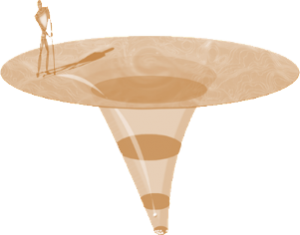Funnel Technique

- Motivate questions
- Open Neutral Question
- Listen to answer
- Ask logical questions to the answer you get, funnel down with open and leading questions
- Get acceptance with a closed leading question
In depth
At the start of a conversation, you should ask neutral and open questions. As you receive information and build up a good conversational climate, you can introduce leading questions as well. This allows the sales representative to steer the conversation towards relevant areas.
During the sales call, the funnel technique is applied to the different types of question. This is because the questions have different purposes – you may be trying to identify the customer’s needs, receive confirmation that you are agreed or steer the conversation towards areas which are important for clarifying the benefits of the offer for the customer.
You should start with general questions focusing on the customer’s business and commercial situation.
Example:
How will your industry be developing in the next few years?
What are your most important target groups for the new service?
Once you have an answer to these questions, based on this knowledge you can start to ask problem-oriented questions. These concern the customer’s problems, challenges, difficulties or opportunities for development.
Example:
What are the limitations of the current system?
What do your customers say about your current offer?
Once you are sure that you have a good overview of the customer’s situation and problems, you should dig a little deeper in this area with some problem-probing questions. This type of question focuses on the potential impact and consequences of the customer’s situation. The purpose of these questions is to identify the elements of the sales representative’s offer which the customer will see as the greatest benefits.
Example:
What consequences does this have for other departments?
What are the greatest risks from not dealing with this issue?
Once you believe that you have sufficient information, the problem-solving questions should be introduced. These are aimed at identifying the specific needs of the customer.
Example:
What is currently the top priority for your department regarding this situation?
What positive impact would these measures actually have?
The funnel technique allows the sales representative to show the customer their professional knowledge and expertise. The sales representative must actively listen and constantly analyse the information received and ask the right follow-up questions. If this is carried out in a professional manner, the customer will notice that the sales representative is attentive, is drawing the right conclusions and understands their situation.
